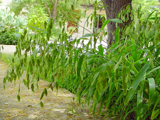Native Plants

Q. Who is Mr. Smarty Plants?
A: There are those who suspect Wildflower Center volunteers are the culpable and capable culprits. Yet, others think staff members play some, albeit small, role. You can torture us with your plant questions, but we will never reveal the Green Guru's secret identity.
Did you know you can access the Native Plant Information Network with your web-enabled smartphone?
Ask Mr. Smarty Plants is a free service provided by the staff and volunteers at the Lady Bird Johnson Wildflower Center.

rate this answer
Friday - April 29, 2011
From: Charlotte, NC
Region: Southeast
Topic: Grasses or Grass-like
Title: Plants for creek bank in North Carolina
Answered by: Nan Hampton
QUESTION:
I would like a list of plant options to plant on an almost vertical creek bank in some location in Charlotte, NC. The creek runs through a 300 acre basin, maybe 3 or 4' high banks and I have never seen the creek out of its banks. Many large trees line the creek and large roots have been undermined along the creek over time and eventually collapse onto the creek. I am looking for some plant material that could be planted on the slopes that would not take over the entire area over time. I am looking for something that is not wild looking as this creek runs through several parks for a large, upscale residential development.ANSWER:
If the slope is very steep (as you have indicated), you are probably going to need to create some mechanical means to hold any plants or seeds in place until the plants can become established. One possibility is to use some sort of erosion control blanket. The erosion-control fabric works by slowing runoff water and allowing sediments to fall out rather than be washed away. Seeds are sown under the erosion-control material and grow up through the matting when they germinate. You can insert plants into the soil by cutting through the matting. The roots of the plants that are growing through the erosion-control material anchor the soil to stop the erosion. If you use erosion-control blankets made of biodegrable material, they will eventually disappear leaving the plants to control the problem. Erosion control material is available at many nurseries. There is an excellent article, Biotechnical Streambank Protection: the use of plants to stablize streambanks, from the USDA National Agroforestry Center that suggests several other methods. Now to stabilize the area, we recommend grasses for controlling erosion because of their extensive fibrous root systems that serve to hold the soil in place. You can add other perennial herbaceous and woody plants along with the grasses.
Below are some recommended plants native to North Carolina and Mecklenberg County or an adjacent county. Since I don't know the amount of sunlight available or the type of soil for the area in question, you will need to check the GROWING CONDITIONS for each of these plants to be sure that they are compatible with your site.
GRASSES AND GRASS-LIKE:
The grasses and sedges listed below are attractive. Some of them will grow best in full sun, but others will grow in shade and part shade.
Andropogon virginicus (Broomsedge bluestem)
Andropogon glomeratus (Bushy bluestem)
Carex blanda (Eastern woodland sedge)
Chasmanthium latifolium (Inland sea oats)
Muhlenbergia capillaris (Gulf muhly)
Schizachyrium scoparium (Little bluestem)
Sorghastrum nutans (Indiangrass)
FERNS:
Ferns generally grow in moist shade and part shade. Some of the ones listed are evergreen.
Asplenium platyneuron (Ebony spleenwort) is evergreen.
Athyrium filix-femina ssp. asplenioides (Southern lady fern)
Dryopteris carthusiana (Shield fern) has sterile fronds that are evergreen.
Dryopteris cristata (Crested woodfern) has sterile fronds that are evergreen.
Polystichum acrostichoides (Christmas fern) is evergreen.
Pteridium aquilinum (Western bracken fern)
HERBS:
Ageratina altissima var. altissima (White snakeroot)
Aquilegia canadensis (Eastern red columbine)
Asclepias tuberosa (Butterflyweed)
Conoclinium coelestinum (Blue mistflower)
SHRUBS:
Ceanothus americanus (New jersey tea)
Cephalanthus occidentalis (Common buttonbush)
Hypericum prolificum (Shrubby st. johnswort)
Malvaviscus arboreus (Turkscap)
Xanthorhiza simplicissima (Shrub yellowroot)
Here are photos from our Image Gallery of a few of the plants above:
More Grasses or Grass-like Questions
Native grasses for Gilmer TX
March 01, 2009 - I would like to get some native grasses growing on our farm that are good for wildlife - barnyard grass - sedges - smartweed - have read and heard that all I need to do is disc and fertilize - yes/no ...
view the full question and answer
Recreating a wildflower meadow, central Texas
July 02, 2013 - We have an acre on our property that has bluebonnets. Unfortunately, it also has other plants that we don't want -Johnson grass, nettles, burrs.
We plan to do a controlled burn in the fall and re-...
view the full question and answer
Should wait to trim Inland Sea Oats until all seeds have been dropped from Austin
March 18, 2011 - Regarding Inland Sea Oats: I trimmed the stalks that have lost all the seeds. Should I trim the rest of the stalks or wait until all seeds have dropped?
view the full question and answer
Ground cover for a Texas dog run
November 02, 2015 - What ground cover do you recommend for a residential dog run located under a pergola in high limestone soil at White Rock Lake in Dallas, Texas?
view the full question and answer
When to move eastern gamagrass (Tripsacum dactyloides)
September 18, 2010 - I have a huge Eastern gamagrass clump that I need to move. What is the best time of year to transplant native grasses
view the full question and answer
| Support the Wildflower Center by Donating Online or Becoming a Member today. |

